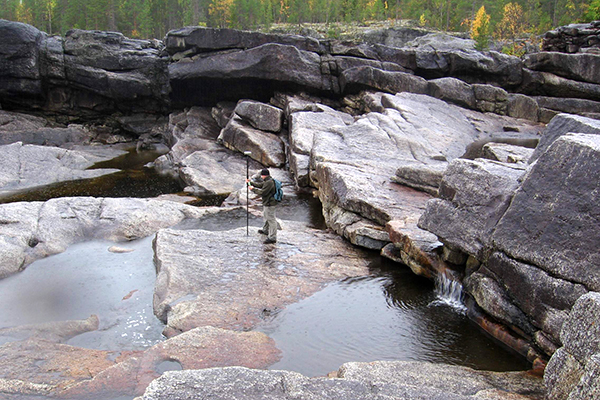May 12, 2014
Rivers under ice sheets sculpted ancient landscapes
A century-old debate over how deep gorges were cut into ancient Scandinavian landscapes appears to have taken a new turn following unexpected data showing rivers of melting ice under glaciers carved deep into the bedrock.
The deep gorges in broad glacial valleys were previously thought to have been formed by rivers flowing after the glacier retreated or at an earlier stage by rivers of meltwater under the ice.
The meltwater theory has been difficult to substantiate and an international research team led by the University of Wollongong’s (UOW) Dr John Jansen, a Senior Fellow at the School of Earth and Environmental Sciences, employed a powerful isotope-based method of dating bedrock surfaces in seven gorges in northern Sweden.
The research showed the gorges in the study area, covered by the Fennoscandian ice sheet which stretched from the British Isles across northern Germany and Russia to the Barents Sea about 20,000 years ago, emerged fully formed from under the retreating ice, rather than being carved out by the rivers left following the glaciers’ disappearance.
Dr Jansen said he expected to find progressive deepening of the gorge over the past 10,000 years caused by flowing water after the glacier melted.
They expected to find that the rocks at the base of the gorges were younger - which would prove they had slowly deepened over time. Instead the team were surprised to discover that the rock in the gorges was the same age at every place they measured.
“Our measurements indicate that the bedrock surfaces are the same age nearly everywhere we measured them, from the top of the gorges down to their bases. This was a set of results totally at odds with post-glacial river incision,” Dr Jansen said.
“The simplest explanation for the consistency of the ages of the bedrock surfaces is that the gorges already existed when the ice retreated, and therefore must have formed by meltwater under the ice.”
Carving out a gorge under a glacier would require huge amounts of water melting and forming rivers powerful enough to both erode the bedrock and flush out debris.
“This amount of water is produced by intense surface melting and probably signifies an ice sheet in an advanced state of decay,” Dr Jansen said.
Parts of the Greenland ice sheet undergo strong surface melting each summer, but the Fennoscandian ice sheet was in much worse shape at the time the gorges were formed, retreating at up to 1000 metres per year, he said
“We think that within 200 to 300 years of the inner gorges forming, the last remnants of the Fennoscandian ice sheet retreated to the Sarek Mountains in Sweden and then vanished altogether about 9,900 years ago.”
Dr Jansen, an adjunct researcher at Stockholm University, led the research while at the University of Glasgow on a three-year fellowship awarded by the UK Natural Environment Research Council.
The next challenge for the team is to tackle another age-old debate about why so many Scandinavian mountains have flat-topped plateaus.
The paper ‘Inner gorges were likely cut by subglacial meltwater during Fennoscandian ice sheet decay’ was presented this week at the European Geosciences Union conference in Vienna, and published in the journal Nature Communications on 9 May.
